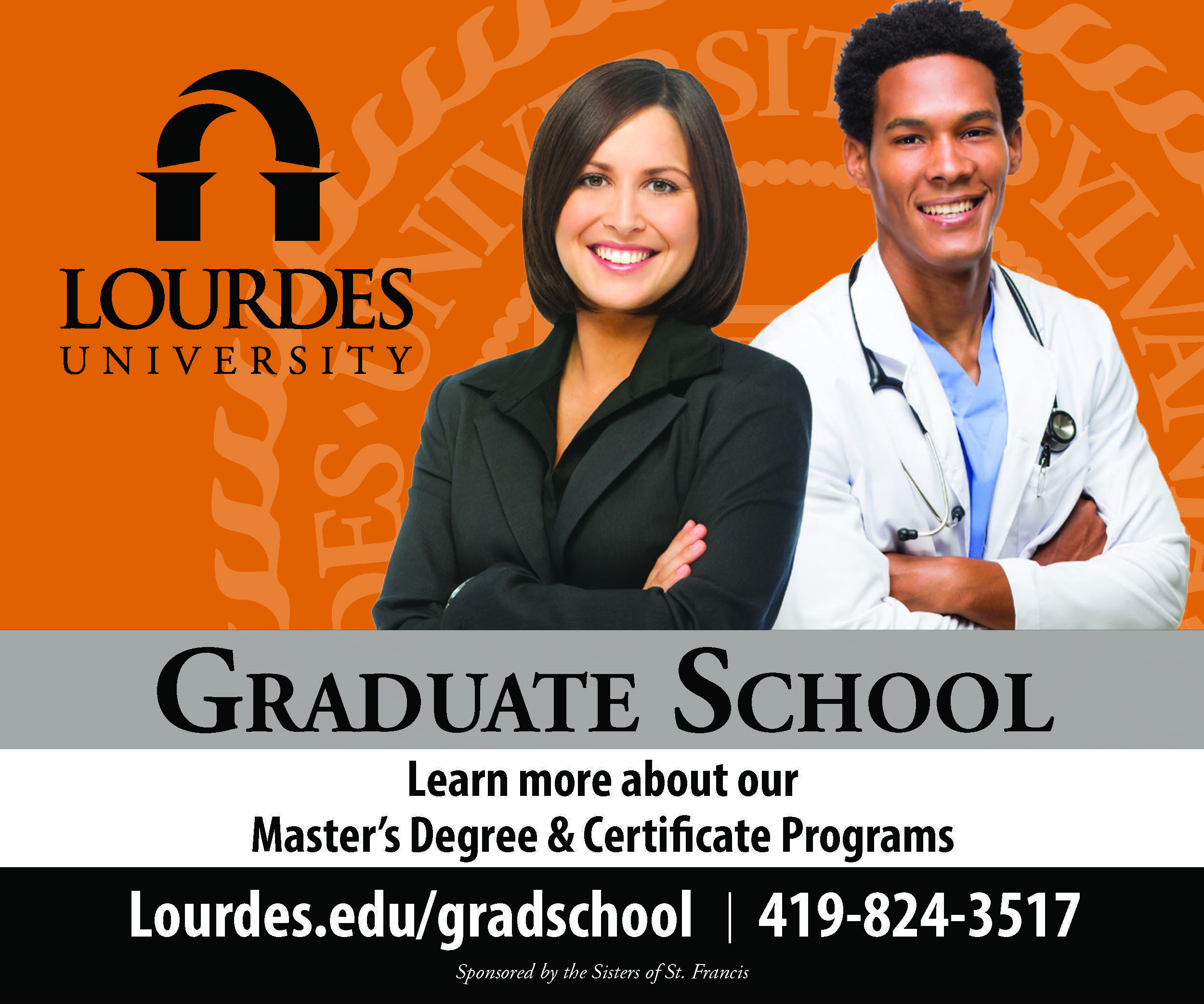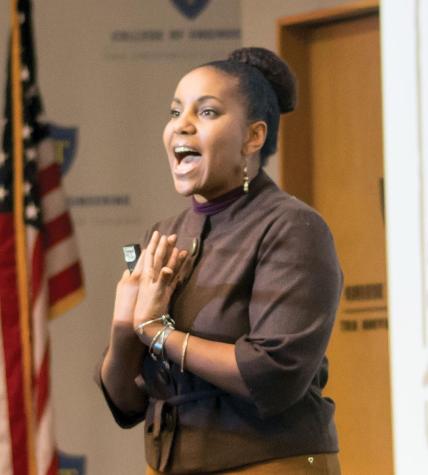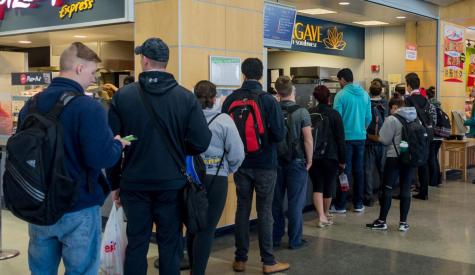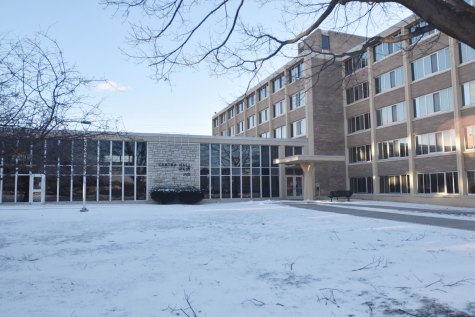Not defined by disability
A blind senior shares personal insights and reflects on her college journey
Rachael Spangler, a blind sixth-year student at the University of Toledo, shares her personal experiences regarding blindness and explains how they’ve shaped the person she’s become today.
Rachael Spangler, a blind sixth-year student at the University of Toledo, shares her personal experiences regarding blindness and explains how they’ve shaped the person she’s become today.
February 25, 2015
Filed under Community, Top Stories
Hang on for a minute...we're trying to find some more stories you might like.
Email This Story
I found Rachael Spangler standing alone and alert beside a brick wall, her bubblegum-pink cane beneath a straightforward gaze.
As I touched her arm to greet her, a hearty smile spread across her face. Her wandering brown eyes didn’t bother finding me — my voice was all she needed.
Spangler is blind. Born with a degenerative eye condition known as retinitis pigmentosa, her retina, or the layer of eye tissue that converts light images to nerve signals and sends them to the brain, is damaged.
“I have a rare form where my parents both carry this really rare gene,” Spangler said. “Apparently the doctor told my parents that they’d have a better chance of winning the lottery than find another two people who carry the same gene.”
Currently in her sixth and final year at the University of Toledo, Spangler is majoring in special education with a focus in vision impairment.
“Yeah, I think I’m pretty highly qualified to do that kind of thing,” she joked.
And Spangler isn’t alone — about 500 students at UT have self-identified with Student Disability Services, according to department Director Toni Howard.
At the age of 8, Spangler said she could point out red objects to her parents, but now the 24-year-old has no sense of color. However, her world isn’t as dark and dreary as you might think.
Sitting casually at an office desk, hands neatly folded in her lap, Spangler pointed to a reflective laptop cover on her right that glistened ever-so-slightly beneath the room lights.
“I wouldn’t be able to tell you exactly what I’m looking at, but it blocks the light so it’s like a shadow and I can see that,” she said.
Despite her visual anomaly, Spangler said color still holds a special place in her life, just not a traditional one. She “sees” color by trying to associate colors with objects that she knows.
Hence, her salmon-colored floral scarf, highlighter-pink shoes, lacy, purple blouse and neon-pink winter jacket.
“When I think of pink and purple, I think of those as pretty colors,” Spangler said. “Not that any of the other colors aren’t, but it’s like, generally when I think of something bright and pretty, I think pink.”
“Bright and pretty” is also the color of her folded lightweight cane she uses to navigate. “Being in step,” or extending the cane opposite of your stepping foot, is how Spangler ensures she doesn’t run into anything.
“If my left foot is about to go forward, my cane should go over here because I want to clear it before I step,” Spangler said, standing to demonstrate the technique.
Photo courtesy of Rachael Spangler
Spangler was born with a degenerative eye condition known as retinitis pigmentosa. At 8 years old, she could point out the color red, but now the 24-year-old has no sense of color. Majoring in special education, she plans to work with local, visually impaired children after graduation.
Spangler resides in downtown Toledo with her older brother Robby, a 2012 UT gradate who is also blind. Together, the duo manages everything from navigation to doing household chores.
“I won’t say it’s not challenging, but I mean, everything has its challenges,” Spangler said. “And he likes to cook, so that kind of helps.”
Spangler said she usually takes the TARTA bus to campus, gets off on Bancroft, then crosses the street to University Hall, her most familiar location. Walking to class, she estimated, takes her about 10-15 minutes if the weather is good.
Getting around on-campus wasn’t always easy though, especially during her first semester when she found herself lost in a wide-open space in Centennial Mall. Frustrated and homesick, she found a set of steps and sat down to cry.
“I called my mom and was like ‘I want to come home. I hate college,’” Spangler said. “But then I thought about it and I’m like, well I could sit here and cry and be upset or I can get up and continue walking around.”
And indeed she did. She summoned the courage to ask a stranger for help and hasn’t looked back since.
As we left the on-campus office, I asked her to take me to one of her classrooms in Gillam Hall. Once outside, she released her soft grip on my right arm and took charge of her surroundings, guiding me swiftly into the Student Union and past one of her landmarks of smell — the unmistakable pungent aroma of roasted coffee beans at Starbucks — all while keeping “in step.”
A fan of Starbucks’ pumpkin spice lattes, Spangler said she frequents the café at least once a week, but admitted that waiting in public lines makes her feel insecure.
“I get really nervous because if I’m behind a nice person, I can say ‘Can you tell me when the line moves up?’ and it works out,” she said. “But if the person doesn’t want to, I have to keep moving up and I might keep hitting them or tapping them with my cane and then I’m thinking in my mind ‘Oh my God, are they getting frustrated with me?’”
We trekked on, her extended cane sniffing back and forth like a bloodhound on the trail. Some passersby glanced up from their phones and sidestepped her, while others tried to be helpful by holding open doors.
These acts of kindness don’t go unappreciated by Spangler, especially when she needs help reorienting herself in public.
“I would say it’s about fifty-fifty,” Spangler said. “Half the people are like, ‘Sure, it’s this way’ or, ‘I’ll walk there with you.’ But then there’s other people who if they’re uncomfortable with dealing with someone who has a disability, they’ll just keep going as if they didn’t hear me.”
Unfortunately, Spangler has had ample experience with the latter, recalling an incident during her freshman year when a man unloaded from a bus, tripped over her cane and snapped it in half, walking away without saying a word.
“A lot of people are really uneducated when it comes to dealing with people with a disability,” Spangler said.
And it’s more common than you might think — about 12.1 percent of people in the U.S. had disabilities in 2012, according to Cornell University’s Annual Disability Status Report. This means about 37,627,800 people reported at least one disability.
We entered the difficult-to-navigate food court, an area saturated with both fond and painful memories for Spangler.
“I’ve had situations where I’ll be in the food court and I’ll bump into someone’s table because the chairs are everywhere, and I may hear them laugh about it or make a joke about it to their friends, but that’s something I’ve lived with my whole life, so I just kind of brush it off,” Spangler said. “Well, unless I’m having a really bad day.”
And when she is having a really bad day?
She still never snaps back because she’s just “not that kind of person.”
“You just have to realize that there’s going to be good people in this world and there’s going to be people in this world who are just out there to hurt others,” Spangler said. “If I take each situation personally, I’m going to be upset all the time.”
As we took a breath of fresh air, using the sidewalk as a roadmap to reach University Hall, Spangler filled me in on a little secret.
“Blind people are not really good at walking straight lines, just so you know,” she warned me. “At least this one isn’t.”
She reiterated that wide-open spaces lead to navigation issues and can make the blind extremely uncomfortable. Sidewalks, Spangler said, make any journey easier and navigating inside buildings is a piece of cake.
“When you’re blind, landmarks are one of the most important things,” she said. “We use them all the time. Whether it be a sound landmark or something on the sidewalk we can feel, we use all that stuff.”
Without landmarks, getting hurt is all too easy. Spangler recalled various injuries, such as slicing open her hand when she fell on ice and slamming her forehead on the side of a floating staircase. She said the most common injury comes from smashing her shins into benches.
“That spot hits a lot of things,” Spangler said. “I think when I was younger, I had like permanent bruises there. I was always hitting stuff about that level.”
Her cane touched grass to her left, telling her to readjust right. When we hit a bump in the sidewalk, she knew we were almost to the next doorway.
Spangler has a mental map of campus — like a photographic memory, but based on what she can feel from her surroundings.
Because restrooms are a main priority for memorization, Spangler knows where to find them in nearly every building she’s been in.
If not for the cane, you might not be able to tell which of us was the blind one.
“Right when you walk in these doors here, there’s a lobby and there’s chairs everywhere,” she warned me. “Oh, and that metal door divider.”
Even after stumbling briefly into a chair and brushing arms with strangers, Spangler didn’t seem phased. She said that once someone shows her around, she knows where to go.
Although she can’t drive, her excellent sense of learned direction also comes in handy when inside a car.
“I know my way around the city really well so if I’m riding with my friends, I just tell them where to go,” Spangler said. “I tell them to turn off their GPS, like I’ve got this. I have a map in my head of where everything is.”
However, she’s open to expanding that map, and dreams of traveling both the states and internationally someday.
Once we reached her classroom on the fourth floor, discussion turned to academics. Although she said good grades aren’t her main priority, Spangler maintains a 3.6 GPA and can type about 80 words per minute on her special laptop, which uses a text reader to read all of her assignments to her.
That is, except for math, which requires Braille for diagrams.
Though she started learning Braille at the age of five, she said the process of reading and writing it is far more complex than people think.
Braille, she explained, is comprised of six dots that, when placed in different ways, form the 26 letters of the alphabet. It gets complicated when you consider there are over 200 contractions to memorize.
“For example, if you have just a letter ‘c’ by itself in Braille, it means the word can,” Spangler said. “If you have a ‘d’ alone in Braille, it means do. Then take a ‘d’ and put a dot five in front of it, then you’ve got the word ‘they.’”
However, her background in Braille is twice as useful considering she’s involved in UT’s Council for Exceptional Children and hopes to teach local visually-impaired students after graduation.
“I feel like I can relate to them and their personal experiences since I went through all of the same experiences myself,” Spangler said. “Even if I’m not a classroom teacher, I would love to be teaching them how to use technology, read Braille or learn independent-living skills.”
Spangler isn’t all work though. A lover of country and 1960s-70s music, Spangler said she enjoys reading, watching movies and hanging out with her friends. Her favorite movie, Frozen, is one she estimated she’s seen “between 15 and 20 times.”
“I was counting, but I lost track after I saw it seven or eight times,” she said, laughing.
Despite the obvious hindrances of being blind, Spangler said it’s forced her to mature quickly and spurred more bonding with her brother and parents. Her experiences have also strengthened her morals and taught her not to pass judgment on others.
“I always give people a chance,” Spangler said. “If someone sees someone and they don’t look approachable, you might not approach them. But I’m not going to know that so I’m going to talk to anyone. I might get to know the really good person who’s there who someone else may not have gotten to know because they were thrown off by some kind of look.”
We passed another stranger who awkwardly opened the door for us when he saw her cane exploring the tile floor.
Debunking misconceptions about being blind, such as the idea that blind people can’t walk up or down stairs or that they all have fantastic hearing, is one of Spangler’s favorite ways to raise awareness about disability.
“People don’t realize that we’re normal people and we have all the same wants and needs as everyone else,” she said. “I’m just a normal girl trying to get a college degree.”
Hungry for lunch, Spangler slung her bag over her shoulder and thanked me for my time. I held open the double doors and crisp air rushed in, blowing about her blonde hair.
As I watched Spangler walk away, I could hear the faint tapping of her cane on the cracked sidewalk. She knew where she was going — her long strides, infused with an energetic bounce, didn’t falter.










1 Comment